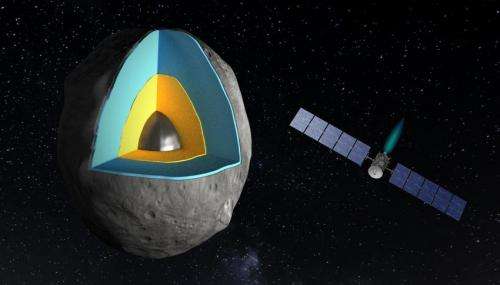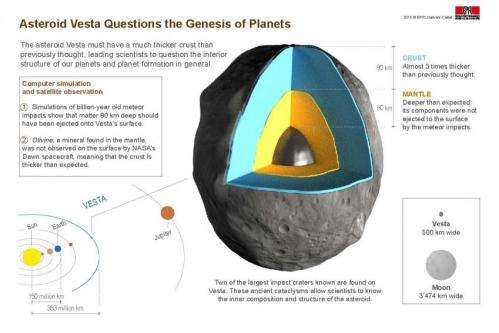Asteroid Vesta to reshape theories of planet formation

EPFL researchers have a better understanding of the asteroid Vesta and its internal structure, thanks to numerical simulations and data from the space mission Dawn. Their findings, published today in Nature, question contemporary models of rocky planet formation, including that of Earth.
With its 500 km diameter, the asteroid Vesta is one of the largest known planet embryos. It came into existence at the same time as the Solar System. Spurring scientific interest, NASA sent the Dawn spacecraft into Vesta's orbit for one year between July 2011 and July 2012.
Data gathered by Dawn were analyzed by a team of researchers from EPFL as well as the Universities of Bern, Brittany (France) and Arizona (USA). Conclusion: the asteroid's crust is almost three times thicker than expected. The study does not only have implications for the structure of this celestial object, located between Mars and Jupiter. Their results also challenge a fundamental component in planet formation models, namely the composition of the original cloud of matter that aggregated together, heated, melted and then crystallized to form planets.
At EPFL's Earth and Planetary Science Laboratory (EPSL), led by Philippe Gillet, Harold Clenet had a look at the composition of the rocks scattered across Vesta's ground. "What is striking is the absence of a particular mineral, olivine, on the asteroid's surface," said the researcher.
Olivine is a main component of planetary mantles and should have been found in large quantities on the surface of Vesta, due to a double meteorite impact that, according to computer simulations, "dug" the celestial body's southern pole to a depth of 80 km, catapulting large amounts of materials to the surface.
The two impacts were so powerful that more than 5% of Earth's meteorites come from Vesta. "But these cataclysms were not strong enough to pierce through the crust and reach the asteroid's mantle," Clenet continued.
The meteorites originating from Vesta and found on Earth confirm this since they generally lack Olivine, or contain only minute amounts compared to the amount observed in planetary mantles. Also, the spacecraft Dawn did not find olivine in the vicinity of the two impact craters.
"This means that the crust of the asteroid is not 30 km thick, as suggested by the models, but more than 80 km," said Clenet.

Composition of planets
These discoveries challenge models that describe the formation of Vesta, and consequently the formation of rocky planets in the Solar System, including planet Earth. Cooling theory and "re-melting" phenomena in the depths of previously solidified elements would also need to be reviewed.
As the scientist explained, "The crust might have been thickened by the formation of 'plutons,' that is: igneous rock intrusions, hundreds of meters large, some of which emerged to the surface."
If Vesta has less of a (olivine-rich) mantle and more of a (pyroxene-rich) crust, then the proportion of materials making up Vesta, and probably the Earth and other telluric planets as well (Mars, Venus, Mercury), is different from what was previously expected.
A more complex model of planet formation therefore has to be considered, one that takes into account not only the original composition of planets, but also their orbits, sizes and related cooling times. Vesta is the only known asteroid that has an earth-like structure—with a core, mantle and crust—making it an incredible laboratory for testing hypotheses and theories.
More information: Nature, dx.doi.org/10.1038/nature13499
Journal information: Nature
Provided by Ecole Polytechnique Federale de Lausanne




















